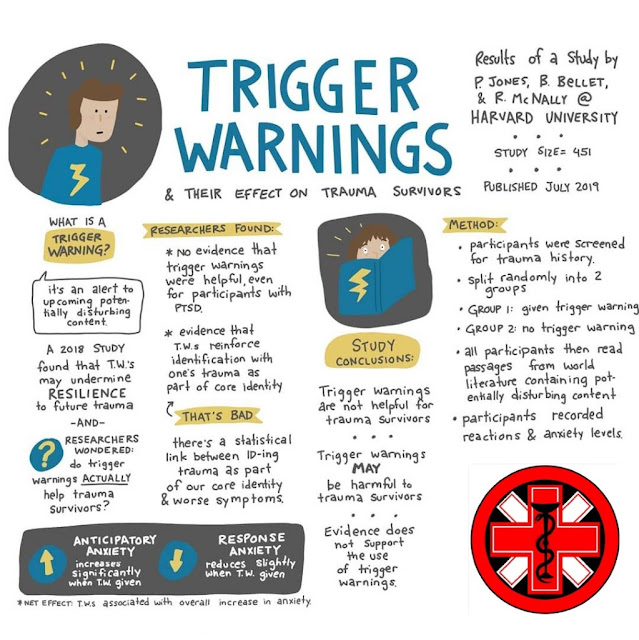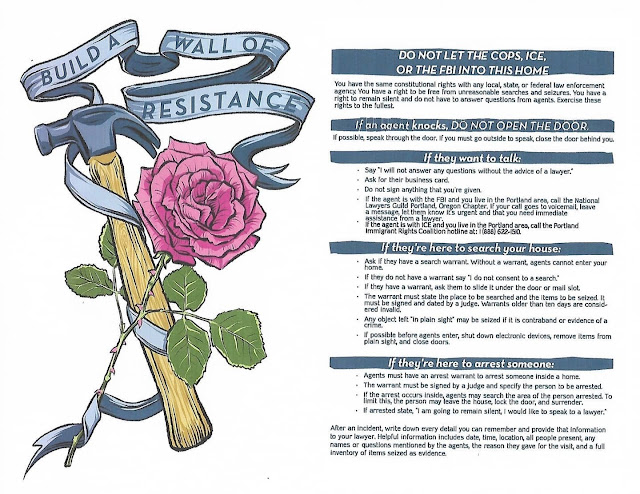Trigger Warnings
The PNW Street Medics Facebook Group (https://www.facebook.com/groups/pnwstreetmedics) is here to provide resources of medical relevance to anyone who is interested. We believe that military medicine, wilderness medicine, and crisis medicine are all relevant to the work that Street Medics do, and we include several related medical references in our Facebook Group Files section, as well as additional information on the PNW Street Medics Blog.
Medical references may contain photos or other graphic representations of serious injuries, street medics may be directly targeted by police violence at protests and demonstrations, and activists (including street medics) may be subjected to "false arrests and detentions, attacks on homes and friendships, and attempts to impede groups from peacefully assembling and demonstrating anywhere, at any time. Harassment from government agencies can be systematic and pervasive.
It was suggested that "trigger warnings" might be included in the PNW Street Medics Facebook Group for some references that we provide. We carefully considered this suggestion and how we might best implement this into the group. What we found however was that Trigger Warnings Probably Don't Work As Planned, and that they may actually cause more harm than benefit.
In general, the evidence on trigger warnings doesn’t line up with what we might expect. Research suggests that trigger warnings neither reduce people’s negative emotions after seeing disturbing content nor do they help people to cope better with that content.
In a 2019 study published in Clinical Psychological Science researchers ran six separate experiments with a total of 1,394 people, randomly assigning some to receive a trigger warning before viewing content and some not to. They varied nearly every component imaginable across the experiments—the type of content (video vs. text), the population (college students vs. other adults), the negativity of the content, and the wording of the trigger warning–and the results were consistent.
Trigger warnings did not reduce participants’ anxiety or negative feelings. They made no difference.
These effects seem to hold both for the general population and for those who have experienced trauma—the very people trigger warnings are often intended to protect. In a study of 451 trauma survivors, participants were randomly assigned to either receive a trigger warning or no trigger warning before reading a passage.
Again, there was no difference in the reactions between groups, even when the content of the passage closely matched the type of trauma the participant had experienced. Unfortunately, trigger warnings did not help trauma survivors to avoid painful memories or brace themselves for upsetting content. (https://journals.sagepub.com/doi/10.1177/2167702619827018)
.
The View of Most Mental Health Experts
An abundance of research evidence indicates that trigger warnings (TW) are not effective in avoiding possibly disturbing content or reducing the level of anxiety experienced when viewing the content (Bellet et al., 2018; Jones et al., 2020; Bridgland et al., 2023). In light of this evidence, mental health clinicians and academics have been consistent in their disapproval of the use of these warnings.
Following is a summary list of the points made by Psychology Today authors about the potential harm of the pervasive use of TW to both survivors of trauma and the general public using social media.
1. Trigger warnings tend to backfire. A warning not to view something can paradoxically cause people to become more curious and interested in the content. This is called the forbidden fruit effect, and it was evidenced in a recent meta-analysis. When given TWs, research participants with a history of trauma either showed no difference in their frequency of engagement or showed an increase in their engagement with the disturbing content (Bridgland et al., 2023).
2. Anticipatory anxiety increases when TWs are given. Study participants who were given TWs showed more anticipatory anxiety than those who were not shown TWs. They reported more nervousness, concern, and fearfulness before viewing the content than those who were not warned (Bellet et al., 2018).
3. The expectation of feeling distress leads to greater distress. The nocebo effect occurs when expectations of harm or poor outcomes result in worse outcomes than no expectations at all. Study participants who were shown trigger warnings had an increase in anticipatory anxiety but had no benefit from receiving the warnings (Bridgland, 2019).
4. Avoidance of stress or anxiety reinforces the anxiety. The basic purpose behind avoiding triggers is faulty since avoidance leads to further avoidance, and generally leads to ongoing high anxiety about a situation. Treatment of anxiety and PTSD symptoms involves identifying and managing triggers using the tools provided in therapy; its goal is not the avoidance of triggers (Badour et al., 2012).
5. Using TWs reinforces a mindset in trauma survivors that their trauma is a core part of their identity. Those survivors who view their past trauma as a core part of their identity tend to have worse symptoms than those who do not. A person whose identity is based upon being a victim of any kind is likely to see themselves as more vulnerable and less in control of their own life choices (Robinaugh & McNally, 2011; Jones, Bellet, & McNally, 2020).
6. TWs prevent emotional growth. It’s through facing and accepting fear, allowing it to pass, and knowing that it will end, that we gain resilience. We learn that our feelings of anxiety are tolerable and that they become more tolerable with practice. In contrast, trigger warnings can inadvertently undermine emotional resilience (Bellet et al., 2020).
(https://www.psychologytoday.com/us/blog/in-it-together/202308/trigger-warnings-on-social-media-posts)



Comments
Post a Comment